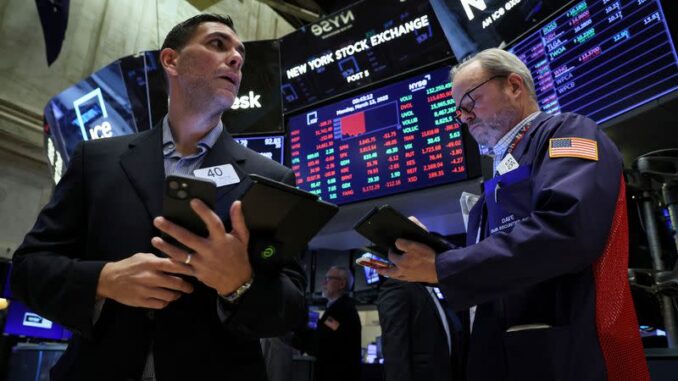
NEW YORK, March 13 (Reuters) – A market rocked by a banking crisis faces a potential one-two punch as investors await a U.S. inflation report that could further complicate views on the Federal Reserve’s monetary policy trajectory.
Tuesday’s report on February consumer prices has been highly awaited for weeks. It has taken on added relevance in recent days, however, following concerns over financial stability after the swift collapse of Silicon Valley Bank (SIVB.O), the biggest bank failure since the financial crisis, and Signature Bank (SBNY.O).
While markets have started to price in a strong likelihood that the central bank will pull back on its interest rate increases to ease pressure on the banking sector, evidence that inflation remains hot could once again ramp up uncertainty over the Fed’s next move – potentially fueling more of the eye-popping gyrations in rates markets that have whiplashed investors over the last few days.
The Fed is “between a rock and a hard place,” said Hans Olsen, chief investment officer at Fiduciary Trust Co. “The rock is they have to deal with inflation and the hard place is they have this banking panic, like a fever that is running through the markets right now.”
Until the recent instability in the banking sector, markets had been fixated on inflation data as perhaps the most significant factor behind asset price moves because of the influence on the Fed’s rate-hiking path.
Markets have been more volatile on average on CPI days over the past year, with the S&P 500 (.SPX) moving an average of 1.8% in either direction on those days against an average 1.2% daily move overall in that time frame.
As of late last week, investors had largely been bracing for a 50-basis-point increase at the Fed’s March 21-22 meeting, but that hefty hike has been priced out of expectations now. Odds of a 25-basis-point hike are about 75%, with 25% chance of no hike at the meeting, according to the CME Group’s FedWatch tool as of Monday afternoon.
Those shifting generations have generated huge moves in Treasury yields. On Friday, yields on the two-year U.S. Treasury bond saw their biggest drop since 2008.
Tuesday’s data could sway expectations once again. CPI for February is expected to rise 0.4% on a month-over-month basis, and 6% annually, according to a Reuters poll of economists.
A hot consumer price report was always going to be problematic for markets, but now “you have this financial stability dynamic interjected into the equation, which further complicates the Fed’s job,” said Walter Todd, chief investment officer at Greenwood Capital.
Indeed, analysts at Capital Economics said a signal from the Fed that it will pause or slow rate hikes could lead to a rise in inflation expectations, if investors concluded that policymakers are no longer as committed to bringing inflation down.
“That might lead to a partial reversal of the recent rally in bonds, worsening the problems in the banking sector,” Capital Economics said in a note.
To be sure, some investors said the market’s focus was elsewhere. Chuck Carlson, chief executive officer at Horizon Investment Services, said developments in the banking sector would likely “outweigh market moves based on the CPI number.”
“Unless it’s a significant outlier, I don’t think it is going to have too much of an impact,” Carlson said of the CPI.
Peter Tuz, president of Chase Investment Counsel, gave even odds that the Fed would either raise by 25 basis points or make no move at the meeting later this month, saying that CPI “might prove to be irrelevant given the current chaos in the financial services industry.”
Still, “I hope it is not a terrible number,” he added.
Source: www.reuters.com



